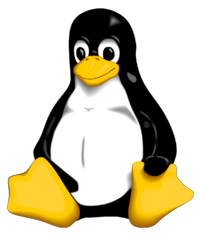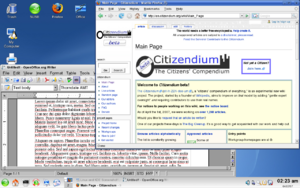Linux (operating system)

Linux is an operating system for Intel-based PC's, notable for running on the same hardware platform as the Windows operating system family, for being a very low-cost alternative to Windows, and for having a user experience nearly identical to the previously very popular Unix operating system. Since its advent in the early 1990's, the rapid growth in popularity of Linux has been a disruptive force within the computer industry.
Linux is open source software, which means it is written and improved upon through a community effort, and it can be obtained and used for free by anyone. Furthermore, numerous companies are able to earn money by offering "supported distributions" of Linux which have certain guarantees in terms of reliability and expected bug fixes, so customers who pay for one of the "supported" versions of Linux (such as Red Hat, or others) can rest assured that someone will help them if a serious problem arises. These specially packaged versions of Linux are called Linux distributions.
The origins of Linux are remarkable. The first Linux kernel was written by an upstart college student from Norway in 1991 in defiance of a competing effort by a renowned professor of computer architecture. The ensuing amicable debate between Linux' creator, Linus Torvalds, and Dr. Andrew Tanenbaum[1] of Vrije Universiteit, The Netherlands, has been retold repeatedly with amusement and amazement.
Although first developed for the the Intel i386 architecture, Linux has since been ported to numerous hardware platforms, including Intel i686, AMD64, SPARC, and Xbox systems. Although it has been very successful in a server environment, Linux has also attained status as a viable desktop platform.
Naming
The original name 'Linux' came from the author's name, Linus, along with the "x" in Unix, to show that it is Unix-like. Linus originally intended to call the project "Freax", for Free and Freak, with the "x" denoting that it is Unix-like, but after one of his colleagues named the system's FTP directory after him, the name stuck.[2]
GNU/Linux naming controversy
In 1984, The Free Software Foundation, founded by Richard M Stallman, made an attempt to create a free Unix-like operating system, which they called the GNU system.[3]
They began with the necessary tools for the system, such as a compiler, debugger, and a text editor. Their plan was to then create a kernel to place beneath the tools that they had created. Unfortunately, the foundation was very late in producing a stable release, and even to this day development of the HURD (the GNU kernel) continues without a stable first release.
It was during this time that Torvalds first introduced his kernel. Before Linux, hackers had no choice but to use non-free kernels, most notably Minix. While the GNU kernel began to look more and more like vaporware every day, the community received Linux with open arms and many began to contribute.
From gnu.org: "Variants of the GNU operating system, which use the kernel called Linux, are now widely used; though these systems are often referred to as “Linux”, they are more accurately called GNU/Linux systems."
The GNU Project members decided to call 'Linux' GNU/Linux, in order to attribute credit to those who worked hard at creating the tools that the Linux kernel runs. Torvalds, however, has made no effort to hide his thoughts towards this naming convention, saying that "calling Linux in general just 'GNU/Linux' I think is ridiculous."[4]
Pronunciation
Linux is pronounced like 'Minix' - that is, "'li' is pronounced with a short [ee] sound: compare prInt, mInImal etc.'nux' is also short, non-diphtong, like in pUt."[2]
Distributions
Linux is typically found as a package of software known as a Linux distribution, also commonly referred to as a "distro". A Linux distribution provides an easy method of installing a Linux system. Distributions come in many forms, from LiveCDs, which extract the system onto a mounted sector of memory, to full installation DVDs. Among the most notable are Ubuntu, RedHat, and SUSE.

Software
Aside from the GNU project's applications, Linux is capable of running many applications of all natures, from games and graphic editors to Integrated Development Environments and web servers. Among the most commonly used applications are The GIMP photo editing tool, which is commonly referred to as a free alternative to Photoshop, Firefox, a very powerful, tabbed web browser, and OpenOffice, which is a free, full-featured alternative to the Microsoft Office suite.
References
- ↑ Andrew S. Tanenbaum, Professor of Computer Science. Vrije Universiteit, Amsterdam, The Netherlands. Retrieved on 2007-04-06.
- ↑ 2.0 2.1 USENET post on Linux naming (Retreived 06 April 2007).
- ↑ About the GNU Project (Retreived 06 April 2007).
- ↑ The "GNU/Linux" and "Linux" Controversy (Retreived 06 April 2007).